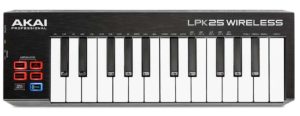Creative features:
The LPK-25 Wireless includes the same features as mention already as the previous version.

By pressing on the left side the ON/OFF button, you activate the very handy arpeggiator module also best known from the old version. The tempo can be adjust either by the advanced features or with the tap tempo button. More in depth parameters, you can find above the keys. On the first part of the keyboard, you have the time divisions for the arp, than the different direction how the arp plays like up down, random. For a continuous running of the arp, it also includes a latch feature. Beside this, you have also a section where you program how many octaves the arp should play and a place for 4 different programs. With a simple press on the prog/select button on the left side and a press on the right key, you can activate the desired function. Last but not least, you have octave down and up buttons for the keyboard also on the left side.
For more in depth adjustments, you can download for free an editor from the AKAI website.
Conclusion
The AKAI LPK25 wireless keyboard was now several weeks during July in the test. It was used, for example, at home on the couch, on the terrace or in the park as my mobile keyboard. On the whole, I can say that I was satisfied with the performance of the small keyboard. Even if the keys are relatively small and it doesn’t replace my current keyboard as daily driver, the LPK 25 wireless is especially an ideal companion to make music on the go. The quality of the key-bed is absolutely fine for the asking price and is enough to make music on the go. One downside, not mention in my video review is the missing mod and pitch wheel. Of course, a very important feature on a Midi keyboard, but considering how slim this device is, you can understand why it was not installed here.
In summary, the AKAI Pro LPK25 Wireless, priced at 69 Euros, is a nice, practical and well- engineered MIDI keyboard for the road. Through the MIDI over bluetooth function, you can even record instruments without cables and leave annoying cables at home. It’s a nice feature but not perfect due of the little problems which I mention before. The device fits easily into every backpack and is therefore a perfect outside and vacation companion. The arpeggiator is still a cool creative additional feature although it doesn’t work with the complete features inside the Bluetooth mode.
Is the 20 € surcharge of the old LPK to the wireless version justified?
In my opinion, yes because, you get a better build quality, a better USB connection compared to the normal LPK 25, a sustain pedal input and MIDI over bluetooth in this version.
Test summary:
+ Key-bed quality
+ Arpeggiator
+ USB-B connection
+ Small and light (fits in every backpack)
+ Battered powered
+/- Bluetooth connection
+/- Missing Pitch/Mod wheel
Check out here my video review

I don’t understand the lack of DIN midi these days. How much can it really add to the cost considering MidiPlus can come out with a 2×2 USB midi interface for $20 retail?
It’s a very low budget keyboard for 69€ and can understand the developers that they includes it only to higher prices keyboards.So they can split their keyboard range in different target audiences. If every keyboard comes with everything onboard, it doesn’t make sense to make different products. In this case, they have for all customers (low budget, higher low budget…) a keyboard. It’s not great but it’s more a marketing/segmentation decision.
How are you able to connect the keyboard wireless to Logic X? I am able to enable Bluetooth via Audio-MIDI Setup, and then press “Apply” on the LPK window that I opened from witin MIDI Studio. Still, I can’t find a way to get Logic to add it. Thanks!